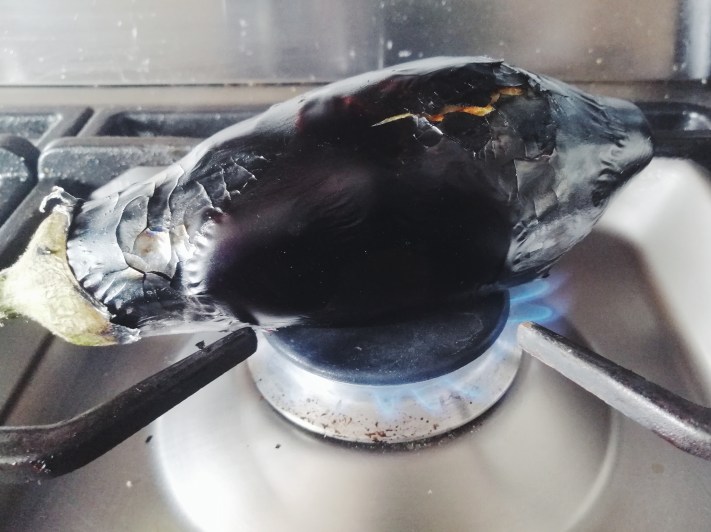Pyromania is a curiosity we all possess. We all went through that worrying childhood phase of literally playing with fire (I refuse to believe I was the only one) and I think a love of cooking, particularly when it comes to charring some aubergines to make babaganoush, is simply an extension of that.

Take blowtorching something for instance. It really is a dangerous tool to give an enthusiastic chef. A cool, confident demeanour can barely contain the gibbering, over-excited child inside screaming, ‘Waheyyyy let’s brûlé this baby!’ Lightly skimming a flame over the surface of sugar-crusted crème is strangely liberating, especially as you watch it turn from pale yellow to the shiny burnt ochre of caramel. Fire makes magic happen.
So, after a few months away from professional kitchens where blowtorches, fire and singed arm hairs are acceptable, I finally decided enough was enough and put an aubergine on a naked flame.

Babaganoush is a smokey aubergine dip and is prepared in various ways across the Middle East – much like a lot of Middle Eastern cuisine, babaganoush goes beyond borders, the artificial dividers of culinary cultures. It is also consumed with wild abandon worldwide.
Smoking aubergines is simple – rest them over a medium-low gas flame and occasionally rotate to ensure the cooking is even. (Although, for a quick fire safety lesson, ideally don’t singe your arm hair, use heat-proof utensils and don’t leave the flame unattended! Thanks.) It is also incredibly satisfying. The black skin blisters and cracks, and tendrils of soft flesh are visible through the gaps. Once the aubergine is soft, squidgy, and begins to collapse and droop, it is ready. Set it in a sieve over a bowl to catch any bitter juices, and leave it for at least an hour until cool enough to handle.

The aubergine itself is a bitter vegetable and tends to demand a lot of attention. Meanwhile, the aim of my game, smoking, is notorious for its astringency and dominant flavour. This is when the other ingredients in babaganoush play their important part.
Tahini, garlic, cumin and lemon are all blitzed with the smokey aubergine flesh, each generously bestowing creamy, smooth, spicy or tangy flavour, soothing that bitterness. Plus, topping your babaganoush with some crunchy, smashed radishes, tossed in melted butter and za’atar – a spice blend of sesame, thyme and sumac – complements the creamy dip by giving you something handy to dunk.

Burning food isn’t always the desired outcome. But sometimes that smokey flavour is hard to beat.
Babaganoush
Ingredients
- 1 medium aubergine
- ½ clove of garlic
- ½ tsp cumin
- 2 tsp tahini
- 1 tbsp lemon juice
- 2 tbsp olive oil plus extra for garnish
- Flaky salt and black pepper
- 1 tsp za'atar
- ½ packet of radishes
Instructions
- Wash and dry your aubergine. Set it over a medium-low flame and keep your eye on it. Once the underside is blistered and grey, rotate the aubergine with heat-proof tongs, ensuring it is smoked evenly. This should take around 5 to 10 minutes depending on the size of your aubergine.If you don't have a gas stove, you can grill the aubergine. Cut it in half and place skin-side up on a baking tray so that the skin blisters and the flesh doesn't crisp or blacken. Keep checking to make sure they are cooking evenly.
- Once the aubergine is wrinkled and collapsing, set it in a sieve over a bowl. Leave it for an hour until cool enough to handle.
- Peel away the crisp flaked skin then, with a wet hand or wet kitchen paper, dab off the excess black specks. Rip the aubergine into chunks and put them in a food processor.
- Crush your half clove of garlic and add it along with the ground cumin, tahini and lemon juice to the food processor. Whiz together until combined and smooth – sometimes babaganoush can be chunky but I find it to be a bit too sloppy – then pour the olive oil through the funnel as it spins, emulsifying into the puree.
- Add a big grinding of salt and pepper, whiz again, then taste. Add more lemon, cumin or salt to taste.
- Spoon onto a plate or in a bowl and garnish with a drizzle of olive oil and the za’atar.
- If you would like to garnish with radishes, rinse them then bash with a rolling pin until cracked. Gently sauté them in a pan with a knob of butter until coated and slightly warm, and season with salt and za’atar.






Leave a Reply